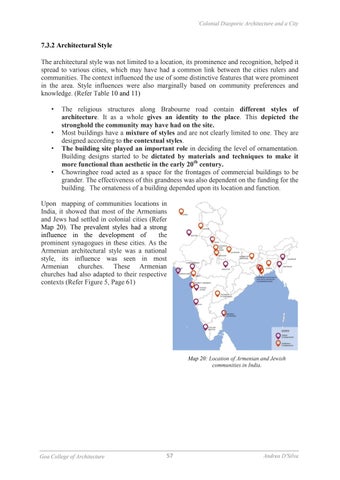`Colonial Diasporic Architecture and a City
7.3.2 Architectural Style The architectural style was not limited to a location, its prominence and recognition, helped it spread to various cities, which may have had a common link between the cities rulers and communities. The context influenced the use of some distinctive features that were prominent in the area. Style influences were also marginally based on community preferences and knowledge. (Refer Table 10 and 11) • • • •
The religious structures along Brabourne road contain different styles of architecture. It as a whole gives an identity to the place. This depicted the stronghold the community may have had on the site. Most buildings have a mixture of styles and are not clearly limited to one. They are designed according to the contextual styles. The building site played an important role in deciding the level of ornamentation. Building designs started to be dictated by materials and techniques to make it more functional than aesthetic in the early 20th century. Chowringhee road acted as a space for the frontages of commercial buildings to be grander. The effectiveness of this grandness was also dependent on the funding for the building. The ornateness of a building depended upon its location and function.
Upon mapping of communities locations in India, it showed that most of the Armenians and Jews had settled in colonial cities (Refer Map 20). The prevalent styles had a strong influence in the development of the prominent synagogues in these cities. As the Armenian architectural style was a national style, its influence was seen in most Armenian churches. These Armenian churches had also adapted to their respective contexts (Refer Figure 5, Page 61)
Map 20: Location of Armenian and Jewish communities in India.
Goa College of Architecture
57
Andrea D'Silva



















